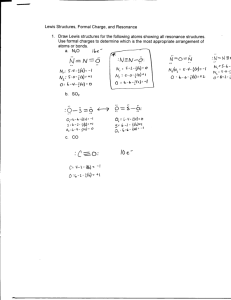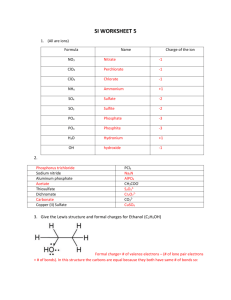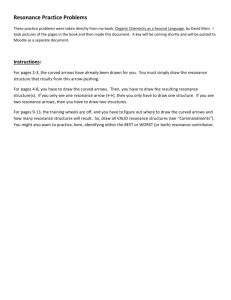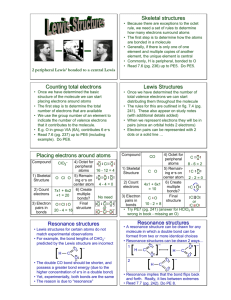Lewis Structures Handout.key
advertisement
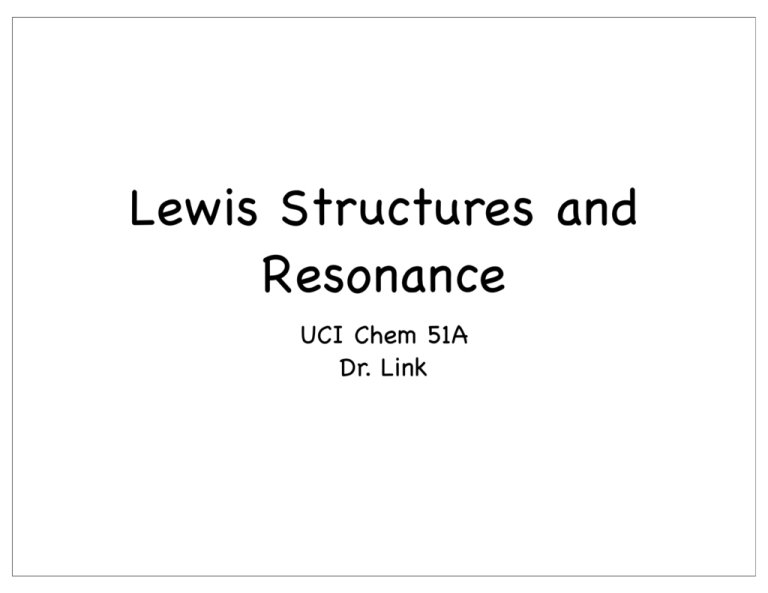
Lewis Structures and Resonance UCI Chem 51A Dr. Link Goals After this lesson you should be able to: 1. Explain why Lewis structures are integral to organic chemistry. 2. Draw valid Lewis structures. 3. Count formal charge. 4. Explain the need for resonance theory. 5. Explain what is a resonance structure and what is not. 6. Draw valid resonance structures. 7. Properly use curved arrow notation. 8. Identify major and minor resonance contributors. 9. Draw the resonance hybrid for a structure. Lewis Structures: Quick Review Lewis structures are representations of molecules that depict bonds and lone pairs. Why are structures needed? In gchem, you used mainly formulas. One Formula, Many Structures C2H6O ethanol dimethyl ether 1 formula can = multiple structures! How to Draw Lewis Structures: 1. Count valence electrons. (As you become more comfortable drawing structures you can sometimes skip this step, but occasionally double-check!) 2. Arrange atoms. Organic formulas will usually give you an idea of how. 3. Draw in single bonds. Distribute lone pairs. Count your electrons. 4. Check for octets. IF NEEDED add double or triple bonds. (Don’t get double-bond-happy!) 5. Maximize octets, minimize formal charge. (More on this later.) Lewis Structure Examples H 2O 8 e- CH3CO2H 24 e- Electron Accounting Methods: Formal Charge Formal charge lets us know if an atom is electron-rich or electron-poor! (Important for reactions later!) Counting formal charge is different than counting for octet rule! Be careful! Counting rules: 1. Count formal charge for individual atoms in a structure. 2. Non-bonding pairs count as 2 electrons. Bonds count as 1 electron. 3. Compare number of electrons in structure to NORMAL number of valence electrons. Extra electrons in structure? (-) charge Fewer electrons in structure? (+) charge Formal Charge Examples SO42- When 1 Structure Doesn’t Show the Full Picture... Our ability to represent the true bonding nature of molecules is limited by the way our brains work and how we draw things! We can draw multiple structures that differ only by placement of electrons. What does this mean? Rules for Drawing Resonance Structures 1. Move electrons ONLY, not atoms. 2. Don’t split up electron pairs. If electrons are paired, move both together. 3. Follow Lewis structure general rules. Note: Expanded octet or non-octets are possible. Resonance Structure Examples -1 -1 +2 -1 -1 -1 +1 -1 -1 -1 -1 -1 +1 The Curved-Arrow Formalism Organic chemists use curved arrows to show movement of electrons. Rules for “arrow pushing”: 1. Arrows show movement of ELECTRONS ONLY! 2. Arrows begin at electrons, so you have two options: A. Non-bonding (lone) pairs B. Existing bonds 3. Arrows end where the electrons are going, so you have two options: A. An atom (to form a new non-bonding pair) B. An existing bond (to form a double or triple bond) THESE RULES ARE VERY IMPORTANT!!! YOU WILL USE THEM IN ALL OCHEM CLASSES!!! Resonance Structure and Curved Arrow Practice NOT Resonance Structure Examples Don’t move atoms! rotation = resonance too many e- on C!!! Resonance Theory Resonance structures are NOT REAL. Resonance structures are NOT IN EQUILIBRIUM. (Note the arrow type.) Resonance structure are NOT ISOMERS. So what are they?! Resonance Hybrids -1 Resonance structures we draw are the extremes of a spectrum. -1 The “real” structure of the molecule is called a resonance hybrid and is somewhere between the extremes. How do we know that? -1 -1 -1 -1 Evidence that Lewis Structures Fail -1 -1 -1 -1 Bond Length C-O C=O 143 pm 122 pm carbonate 129 pm -1 -1 All C-O bonds equal! More on Resonance Hybrids + Fictitious = Fictitious Real! Not All Resonance Structures are Created Equally! Maximize bonds and octets. Minimize formal charge. When formal charge is necessary, (-) on more electronegative atoms, (+) on less electronegative atoms. Major contributors vs. minor contributors. Major and Minor Contributors -1 -1 +1 -1 -1 -1 +1 -1 +1 Wrapping Up Practice drawing Lewis structures, including formal charge. Practice drawing resonance structures, including formal charge. Practice using the curved arrow notation. Practice determining whether a resonance structure would be a major or minor contributor to the resonance hybrid. Practice drawing the resonance hybrid.

